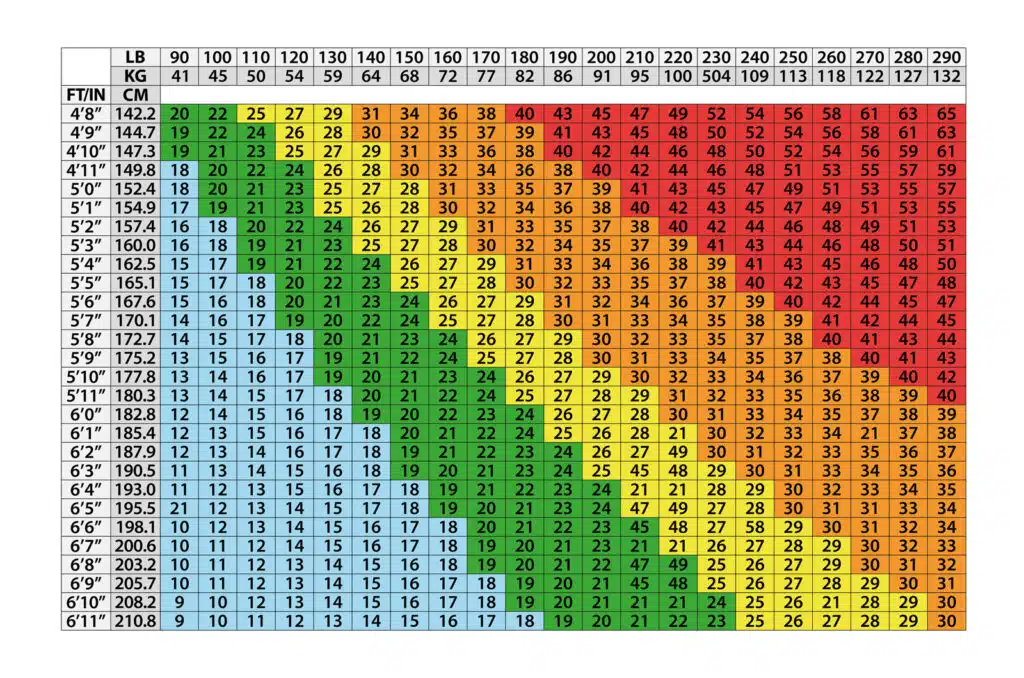Follow this 5-step plan and find out how much to walk according to BMI. Walking to lose weight charts included.
Worried about a high body mass index (BMI) or just your body weight in general? You may know walking is good for you but what about the answers to “How much should I walk according to my BMI?” and “How much do I need to walk every day to lose weight?” This post will give you clear steps to follow to hit your weight loss targets.
Follow this 5-step plan and find out how much to walk according to BMI to get fitter, reach a healthy weight, and lose weight for good.

What Is BMI and Normal Body Weight?
Normal weight refers to your body mass index (BMI). It just means you’re not underweight, overweight, or obese.
| Weight Classification | BMI |
| Underweight | < 18.5 |
| Normal | 18.5 – 24.99 |
| Overweight | 25 – 29.99 |
| Obese | > 30 |
BMI is a quick way to find your ideal weight range. It has a lot of limitations but it’s easy to apply and get a rough idea of whether your weight is in a healthy range. Just note:
- It doesn’t work if you have big muscles – young men who work out often have a BMI in the overweight range despite having a low body fat percentage.
- For older adults and women with low muscle weight, it’s still possible to have a healthy BMI but have health risks associated with too much body fat.
Find your current body mass index with this BMI calculator.
Alternatively, use this Body Mass Index (BMI) Chart:


Height To Weight Ratio
Your body fat percentage is a better indicator of your health but it’s not as easy to measure. Plus not all body fat carries the same risk to your health.
The biggest concern for your health is visceral fat that sits around your belly. Excess visceral fat is linked to:
- Organ dysfunction;
- Impaired regulation of insulin, blood sugar, and cholesterol,
- Abnormal heart function.
It’s possible to have a normal BMI but excess belly fat that’s damaging to your health. A quick check for visceral fat is your height to weight ratio.
- Measure your waist circumference just above your belly button at the bottom of your ribs and the top of your hips.
- Breathe out naturally before taking the measurement
- Using the same units – centimeters or inches – divide your waist measurement by your height.
- A waist-to-height ratio of 0.5 or higher means you may have increased health risks such as heart disease, type 2 diabetes and stroke.
It’s always best to seek medical advice before starting a weight loss or exercise program.
Calorie Deficit
When you know your current body mass index (BMI) and your goal weight, you can calculate how much weight you need to lose.
You need to burn more calories a day than you consume to lose weight.
This is a calorie deficit. Create a calorie deficit:
- just by eating less
- just by walking
- or from walking and eating fewer calories.
Assuming you’re losing just body fat and not muscle, it takes a deficit of 3500 calories to burn one pound of fat.
You will find this figure quoted everywhere. It’s based on research by a scientist called Max Wishnofsky way back in 1958.
This research created the myth that if you eat 500 calories less a day, you will lose one pound of body fat a week.
In reality, this never happens. Why? Because your body adapts to eating less food. It switches into starvation mode (technical term adaptive thermogenesis).
Your body becomes more efficient at burning calories, you move around less and you burn muscle as well as body fat. This makes it almost impossible to maintain your weight loss.
Diet and exercise are equally important for losing weight.
How Much To Walk According To BMI Calculator
This walking calories burned calculator will give you an accurate estimate of the calories burned based on your current body weight and walking pace.
If you want to lose one pound of body fat a week by exercising aim to burn 500 calories a day from walking. That’s typically 3 to 5 miles a day depending on your current weight.

How Much Should I Walk According To My BMI Chart
To get a healthy BMI you just need to walk off the weight!
| BMI | Below 18.5 (Underweight) | 18.5 – 24.9 (Normal/Healthy) | 25 – 29.9 (Overweight) | > 30 Obese |
| Miles Per Day | 1 to 3 | 5 | 5 | 3 – 5 |
| Steps Per Day | 2,000 to 7,200 | 10,000 to 12,000 | 10,000 to 12,000 | 6,000 to 12,000 |
Use the Calories Burned Walking Calculator to find out how many calories you’re burning based on your current weight and walking pace.
A typical person burns 100 calories per mile walking at a brisk walking pace. Brisk walking is a sustained effort. Your heart rate will be elevated but you’ll still be able to hold a conversation.
How many miles?
To lose one pound of body fat just from walking you need to walk 5 miles a day or 35 miles a week. Aim for daily walks – it’s regular walking that gets results. That’s approximately 10,000 to 12,000 steps a day or 70,000 – 84,000 steps a week depending on your stride length.
It sounds like a lot doesn’t it? But you can split up your miles into 2 or 3 walks a day.
| Daily Goal | Weekly Goal | |
| Miles | 5 | 35 |
| Steps | 10,000 – 12,000 | 70,000 – 84,000 |
| Time (hours) | 1:15 to 2:00 | 8:45 to 14:00 |
5 miles a day is too much for beginners.
Don’t start a walking plan at 5 miles a day unless you’re already an experienced walker. You’ll just get too tired or injured.
How much should I walk?
If you’re new to exercise with a higher BMI, start by walking 1-2 miles a day. That’s about 2,000 to 5,000 steps.
Related post: How To Lose Weight Walking 2 Miles A Day.
At the start of a walking program, your body will be working hard. You’ll burn calories at a rate of more than 100 per mile. So don’t worry if your walking duration isn’t long enough in the first couple of weeks.
For best results follow my 9-Week Fat Buster Walking Challenge.
This weight loss program starts slowly at a level almost anyone can manage. As the weeks go by, walking distance and walking speed gradually increase.
As you adapt to the exercise regime, the program makes you work harder until you’re walking 5 miles a day.
How Much Can You Eat On A Walking For Weight Loss Plan?
Walking to lose extra weight loss isn’t about controlling calories. You just have to make sure you’re not eating excess calories.
That’s more than your body needs for its day-to-day activity.
Based on the Dietary Guidelines for Americans (2020-2025), most female adults typically need 1600 to 2400 calories per day, and male adults 2000 to 3200.
Age, gender, body composition, metabolism, and the amount you exercise all account for the huge differences.
To lose weight by walking, find your daily calories for a sedentary lifestyle based on this Daily Energy Expenditure Calculator.
Keep within this limit for your daily calorie intake and the extra calorie burning from walking will reduce your excess weight.
What if walking makes me hungry?
This can be a problem, especially in the first few weeks. Try to fill up low-fat meals high in protein.
Follow the tips in this post What To Eat After Walking For Weight Loss.
What if I’m eating too much?
Try making small, sustainable changes to your diet to eat fewer calories. If you try and change your diet too much too soon, you will fail.
Try and cut down on high-calorie food such as cakes, junk food, and takeaways. Sugary drinks can be a high source of hidden calories. Switch to drinking water – it’s far more refreshing, especially after exercise.
Help, I’m walking everyday but gaining weight!
It’s normal to gain a few pounds over the first week or so. This will be from fluid retention.
Exercising causes small micro tears and inflammation in your muscle fibers. This inflammation causes water retention.
It’s temporary. As your body adapts to your new walking regime, your body will shed the water weight. So don’t give up!
Find out more in this related post: Why You’re Not Losing Weight Walking?

5-Step Plan For Walking For Weight Loss
Hit your weight loss goals with this 5-step plan and walk-to-lose weight chart:
Step #1 Find your current BMI.
Use this BMI calculator to find your body mass index based on your height and current weight.
Step #2 Find your normal weight.
The chart below provides the normal weight for different heights. This is the figure at the top end of the normal weight range. It’s best to be a few pounds below this figure to allow for weight fluctuations.
Find your normal weight below and subtract 2 pounds. This is your weight loss goal.
| Height (feet and inches) | Normal Weight Upper Limit (pounds) |
| 4 ft 10″ | 119 |
| 4 ft 11″ | 123 |
| 5 ft | 127 |
| 5 ft 1″ | 132 |
| 5 ft 2″ | 136 |
| 5 ft 3″ | 140 |
| 5 ft 4″ | 145 |
| 5 ft 5″ | 149 |
| 5 ft 6″ | 154 |
| 5 ft 7″ | 159 |
| 5 ft 8″ | 164 |
| 5 ft 9″ | 168 |
| 5 ft 10″ | 173 |
| 5 ft 11″ | 178 |
| 6 ft | 183 |
| 6 ft 1″ | 189 |
| 6 ft 2″ | 194 |
| 6 ft 3″ | 199 |
| 6 ft 4″ | 204 |
| 6 ft 5″ | 210 |
Step #3 How many pounds do I need to lose?
Simply subtract your goal weight from your BMI calculation.
Step #4 How much should I walk according to my BMI?
Use the table below to find out how long it will take to hit your weight loss goals if you’re walking 2 miles, 3 miles, 4 miles, or 5 miles a day.
These figures are approximate. If you have a lot of weight to lose, your weight loss will be a lot faster over the first 4 to 8 weeks. It will also be a lot harder to lose the last 10 pounds to hit your target than it is to lose the first 10 pounds. Why? Because when you weigh less, your daily calorie requirements are lower.
| Miles per day | Weight loss per week (pounds) |
| 2 | 0.4 |
| 3 | 0.6 |
| 4 | 0.8 |
| 5 | 1.0 |
| 6 | 1.2 |
I recommend walking every day. Walking is a low-impact activity with less injury risk than running.
Providing your walking isn’t more than 5 miles a day and you build up to this level gradually, most people can cope with walking daily. Just make sure you have a good pair of walking shoes or trainers – you don’t want to get any blisters!
Step #5 Monitor your results
It’s best to keep a walking journal to record your miles walked and progress towards your fitness goals.
If you’re struggling to reduce weight try and work out why.
- Are you walking regularly and hitting your distance targets? Make sure walking is part of your daily routine.
- Are your efforts at a brisk walk pace? Walking for weight loss isn’t just taking a stroll – you should be making a consistent effort.
- Is walking too easy for you? Follow the suggestions in this article about How To Get Results Walking For Weight Loss.
- Mix things up by walking uphill or following the suggestions in this daily walking workout schedule.
- As you get fitter, consider running for weight loss. You can burn more calories per mile but it doesn’t suit everyone.

Thoughts From Love Life Be Fit
Walking is a good way to reduce a high BMI and start leading a healthy lifestyle. In theory weight loss is simple: move more and eat less. In practice, it can be a lot harder but keep monitoring your results and make sure you adapt your walking sessions as you get fitter.
If you struggle to hit your daily walking target, split your walks and long distances into 2 or 3 sessions. It’s the number of steps you take that will count – you don’t need to complete your target walking distance all in one go.
Aim for healthy weight loss. Being underweight can be dangerous for your health and it’s never a good idea to try and lose weight too quickly.
Concerned about your health, please seek medical advice. If you have an existing medical condition, you haven’t exercised in a long time or you’re carrying a lot of excess weight it’s a good idea to talk to your doctor before starting a walking program.
